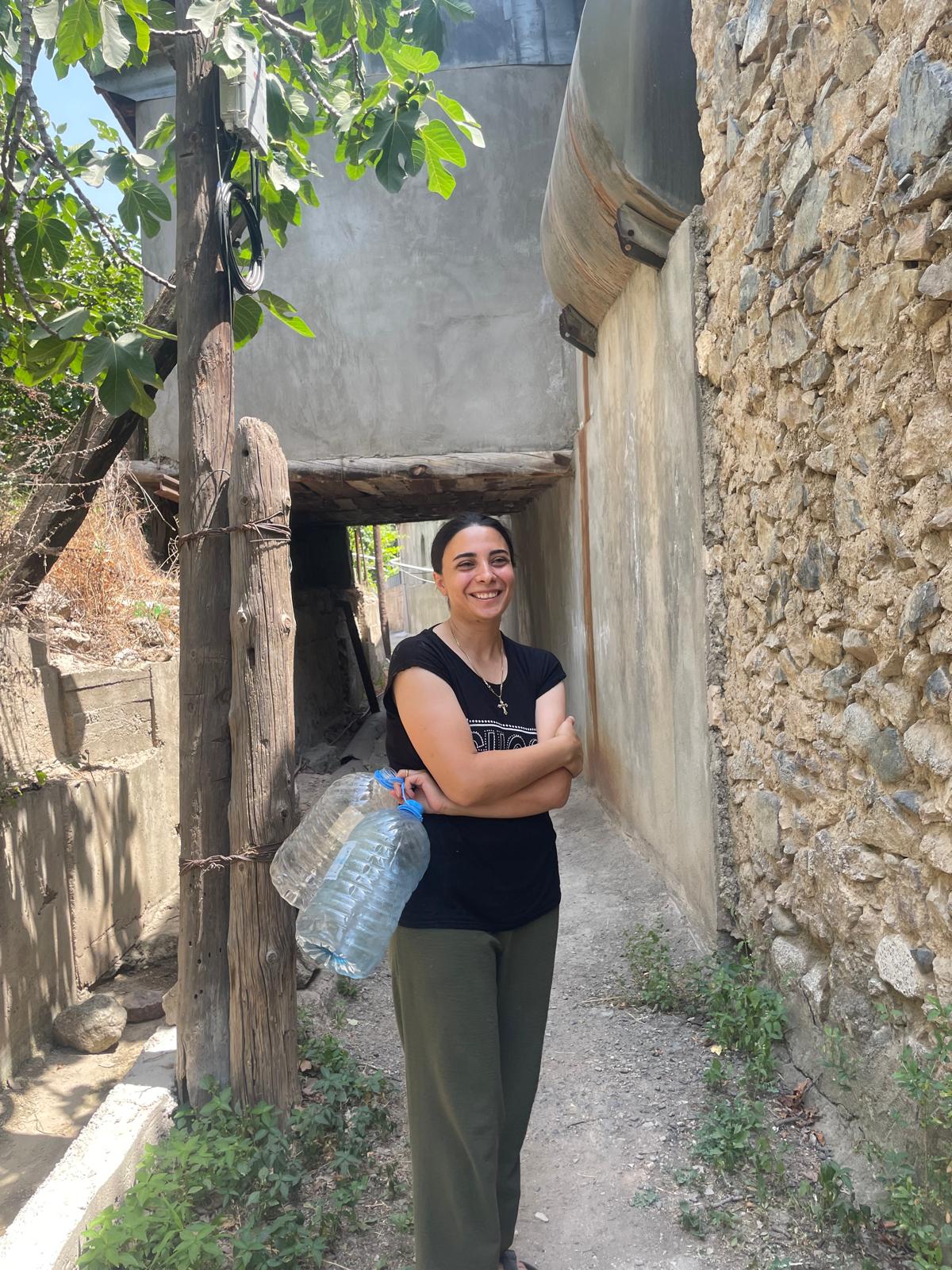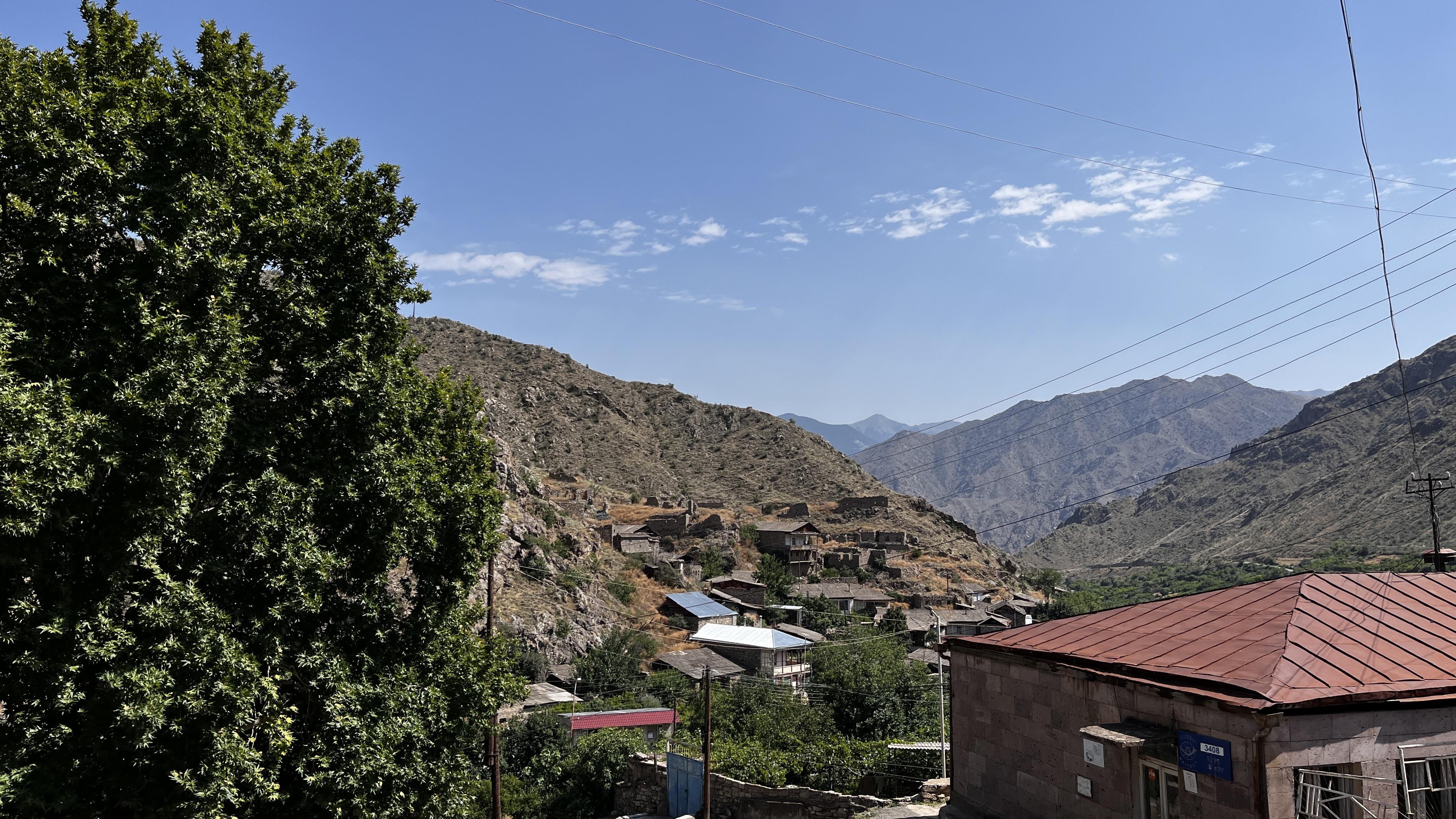
Armenia's Shvanidzor: A Parched Fortress Village
By Martha Gathercole
I catch Shvanizdor in full daily flow during the driest spell of the year. Village residents queue up with big empty bottles of water at the aqueduct, their source of hydration, cleaning, and livelihood for the next few months.
This is Shvanidzor in its driest months: July and August. Located on the border with Iran in the Meghri region, it is one of Armenia's southernmost villages, and one of its most remote. Located in the country's semi-arid zone, Meghri has one of the lowest precipitation levels in Armenia, with an annual average of 200-250mm.
It is easy to find people to talk to since they're coming and going to collect water here several times a day. We speak to Emma, a woman walking down with her daughter to collect water. She explains the struggles the village faces in these dry summer months, but also proudly tells me about the fruits that her family is growing: persimmon, figs, pomegranate. “Ninety percent of our village is arable agriculture” she says.
Whilst speaking to us, she sends her daughter down to fetch more water. Another woman joins her to collect water, recounting how Shvanidzor was once a “fortress village”, defending itself against both Russian and Turkish occupation. This was in part thanks to the fact that the aqueduct allowed the village to be self-sufficient when under threat.
This military strength bred prosperity. Shvanidzor used to be a prominent producer of wine and fruit. Now, however, this is not the case. The aqueducts are drying up due to climate change and a lack of government aid to implement improvements.
Emma carrying bottles to fill up at the aqueduct
When Hetq visited Shvanidzor on July 20, the village hadn't had any running water in the taps for fifteen days. Residents in recent years have not had running water for five months per year, and are forced to fill up bottles at aqueducts. The woman collecting water points out that one of the aqueducts provides drinking water, although this will soon run dry too. The other is constantly flowing, but too salty to drink, and so is used for plants instead. Winter is also a challenging period, residents tell me, as pipes freeze up.
Villagers are unanimous that the water supply from the aqueduct is decreasing each year due to climate change and that the water supply was unmistakably better during Soviet times. According to the United Nations Development Programme, between 1935 and 2007, June precipitation levels have reduced by sixty percent, and the number of consecutive dry days per year over this period has increased by eighteen days. The problem does not seem fixable: the gorge itself where the water comes from, is drying up.
There are also other factors that can affect the water flow of the aqueducts. Hetq spoke to former vilage mayor, Hovhannes Ohanyan, and his friend, whom he calls the “last master” of the aqueducts. They explained that the small underground earthquakes, which happen three or four times per month, damage the efficiency of the aqueduct. Any concrete or cement that is broken in these aqueduct structures allows water to fall through cracks.

Holes are created in the mountainside called kahrezes, tapping into water flows within. The highest peak of the surrounding mountains is 2864 metres above sea level. From there, water flows down to the base layer (450m above sea level) and out into the aqueduct.
Methods of survival
Emma tells me how the residents here live day to day. “It is incredible that we live so close by (to the aqueduct), but in a few days there won't even be water here and we will have to buy drinking water from the shop.”
The nearest shops are up on the outskirts of the village and in Meghri – roughly a twenty minute car drive away. For irrigation, there are sources of water near the Russian border checkpoint. For this, villagers have to take big empty canisters there, ask for water, and lug them back. Emma tells us it's best to get there early in the morning because later in the day there is less water available. Many have found solutions for their washing machines, for example by having pumps in their houses to extract the maximum volume of water. These survival tricks, which residents like Emma have mastered, reveal how finding a source of water impacts the daily routine of life here.
Emma tells us:
"We've somehow got used to it: finding solutions so as not to feel the horror of the situation. Everyone manages somehow. Even if we have one hour of water per day, we will find a solution to fill up the tanks."
Water initiative
According to the mayor, in the 2010s, with the help of German aid, villagers constructed a fifth kahreze in the hillside to mitigate the effects of the decreasing water supply. There were complexities to the initiative. They realised one hole was dug in vain when no water was found. This made continuation of the project even more complicated as builders then had to then dig around the abandoned pit. In the end, they found another source which improved the water supply over this period. However, even with the help of initiative, the village finds the aqueduct drying up again.
When Hetq launched an inquiry into this initiative, no information was available. Thus, no dates or details of the German initiative are confirmed by the organisations involved, only by the residents of the village.
According to some of the inhabitants, the neighbouring village of Alvank has a better solution, where there is tap water available during certain allocated hours of the day. Residents also say that the government should implement a similar solution in Shvanidzor, but that this has not happened yet.
Because of damage caused by earthquakes and wear over time, the village aqueduct expert tells us how the aqueduct should ideally be cleaned every three years. The last time he did this was six years ago, he said. As the ‘last master’ reaches retirement, who will take on the responsibility of maintaining the aqueducts, the village's essential sources of life?
"We will do our part, but the government needs to do its job. The people are ready to do anything", says the former mayor Hovhannes Ohanyan. The government has promised solutions, but so far has not initiated anything concrete. When Armenian PM Pashinyan visited Shvanidzor in April, he claimed that he could hear running water, that they should switch it off, blaming the people of the village for the problem. “Wherever you go, people say there's a water problem. When there is water, you use it like this. That's why there is no water.”
There has been money set aside for various projects, mainly from international organizations. This year, according to the EU ambassador Vassilis Maragos, the EU has has allocated 36 million euros for water systems and their maintenance in Armenia.
In April 2025, Pashinyan said that he intends to build the reservoir of Meghri, declaring, “I promise I will solve your village's problem”. He has also commissioned the Minister of Environment to measure how much water flows from the kahrezes in litres per second. But, the government didn't give this number when Hetq asked for it.
I ask Emma if she thinks Pashinyan understands the problem here. “I don't have an answer for that. You need to live here to understand the issue,” she answers. She turns to me: “Even now when you’re talking, it seems very easy for you, but you need to live here to understand.”
Following these Hetq interviews, Meghri Community Head Khachatur Andreasyan visited Shvanidzor on August 7. After seeing that work on a pump in Meghri had long been delayed due to a lack of organisation and absence of a builder, he decided to finally put the project into action. Construction has since begun. Government promises, however, are showing less signs of potential fulfillment.
Hetq contacted Armenia’s Ministry of Territorial Administration regarding a possible solution to the problem, how much money is needed, and what the government plans to do to fulfill its promises. The ministry declined to offer any details, indicating this is included in the Water Committee's next year's budget request.
Many Shvanidzor residents, including Emma, do not believe that the government's promises will be realised. They say there have been no visible steps towards a solution. When I ask the former mayor if he’s confident that this money will be used for the reservoir, he replies: "I hope so, otherwise this region will not survive. If the government does not deliver then the people need to leave."
Indeed, population figures have already shown signs of dwindling. On September 1 this year, there were only three new students entering first grade out of the thirty-three children studying at the school.
The people of Shvanidzor only have one wish.
"We have no complaints at all about anything else. The kids have camps, school, kindergarten, and we have a police force which gives people the possibility to be employed,” Emma tells me. When asked what will happen if there is no solution to the water problem, she responds with the same ominous prediction as Ohanyan: “I think the villages will disappear.”
Shvanidzor was once a fortress protecting the southernmost region of Armenia, and one of the last settlements to hold off Russian and Turkish rule.
Now, Armenia needs to serve Shvandizor in return and fulfill its promises. The village is ready to work as hard as is necessary to secure a water supply. Time will tell to see if the government is ready as well.
The lack of information that the government has given Hetq on the plans to implement the promises made to Shvanidzor is already a bad sign. If the government does not implement changes, or even plan for change, the aqueducts, once a symbol of strength and defiance for Syunik, will eventually dry up.
This Armenian village is not threatened by invaders, but by climate change. Shvanidzor must be protected just as much as any other vulnerable border region.
Coordinator: Nare Petrosyan
 Videos
Videos Photos
Photos



Comments (1)
Write a comment